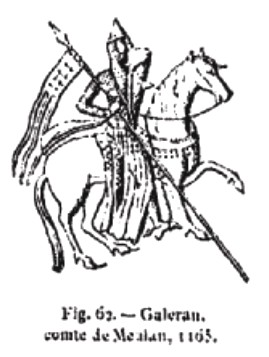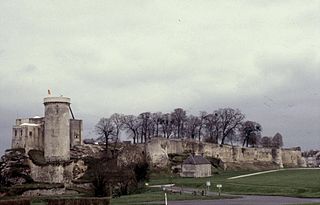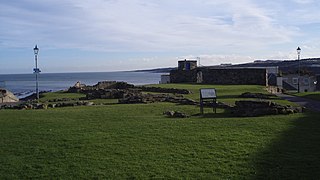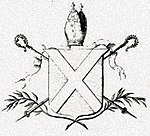Related Research Articles

William the Lion, sometimes styled William I and also known by the nickname Garbh, "the Rough", reigned as King of Scots from 1165 to 1214. His 48-year-long reign was the second longest in Scottish history, and the longest for a Scottish monarch before the Union of the Crowns in 1603.

Year 1153 (MCLIII) was a common year starting on Thursday of the Julian calendar.

Robert de Beaumont, 3rd Earl of Leicester was an English nobleman, one of the principal followers of Henry the Young King in the Revolt of 1173–1174 against his father King Henry II. He is also called Robert Blanchemains.

Kennoway is a village in Fife, Scotland, near the larger population centres in the area of Leven and Methil. It had an estimated population of 4,570 in 2020. It is about three miles inland from the Firth of Forth, north of Leven. This position gave it importance in the old days while travelling by coach, for the stage road ran through Kennoway from the ferry at Pettycur, through Ceres, and on to St Andrews. The street known as "The Causeway" was also added to part of the Fife Pilgrim Way in 2019 due ties with St Kenneth, the Causeway being part of one of the designated conservation areas by Fife Council
Robert de Beaumont, 1st Earl of Leicester, Count of Meulan, also known as Robert of Meulan, was a powerful Norman nobleman, one of the very few proven Companions of William the Conqueror during the Norman Conquest of England in 1066, and was revered as one of the wisest men of his age. Chroniclers spoke highly of his eloquence and his learning, and three kings of England valued his counsel. He was granted immense land-holdings in England by William the Conqueror and by Henry I and was created Earl of Leicester.
The Lord Chancellor of Scotland, formally the Lord High Chancellor, was a Great Officer of State in the Kingdom of Scotland.
Elizabeth of Vermandois, was a French noblewoman, who by her two marriages was the mother of the 1st Earl of Worcester, the 2nd Earl of Leicester, the 3rd Earl of Surrey, and of Gundred de Warenne, mother of the 4th Earl of Warwick.

Waleran de Beaumont, Count of Meulan, Earl of Worcester, was the son of Robert de Beaumont, 1st Earl of Leicester and Elizabeth de Vermandois, and the twin brother of Robert de Beaumont, 2nd Earl of Leicester. He is not referred to by any surname in a contemporary document other than 'Waleran son of Count Robert'.
Ermengarde de Beaumont was Queen of Scotland as the wife of King William I. She is reported to have exerted influence over the affairs of state as queen, though the information of her is lacking in detail. Her paternal grandmother is Constance FitzRoy, illegitimate daughter of Henry I of England.

The Abbot and then Commendator of Melrose was the head of the monastic community of Melrose Abbey, in Melrose in the Borders region of Scotland. The abbots of the earlier Northumbrian foundation from Lindisfarne are not included here. The second abbey was founded in 1136 on the patronage of David I, King of Scots, by Cistercian monks from Rievaulx Abbey, Yorkshire. Control of the abbey was secularized in the 16th century and after the accession of James Stewart, the abbey was held by commendators. The last commendator, James Douglas of Lochleven, resigned the abbacy to William Douglas, 6th Earl of Morton in December 1606, and the abbey itself to the king in 1608. The abbey was then erected into a secular lordship for viscount Haddington, John Ramsay, who in 1609 was created "Lord Melrose". Lochleven however resumed the title of commendator in 1613 until his death in 1620.
Jocelin was a twelfth-century Cistercian monk and cleric who became the fourth Abbot of Melrose before becoming Bishop of Glasgow, Scotland. He was probably born in the 1130s, and in his teenage years became a monk of Melrose Abbey. He rose in the service of Abbot Waltheof, and by the time of the short abbacy of Waltheof's successor Abbot William, Jocelin had become prior. Then in 1170 Jocelin himself became abbot, a position he held for four years. Jocelin was responsible for promoting the cult of the emerging Saint Waltheof, and in this had the support of Enguerrand, Bishop of Glasgow.

The Prior, then Abbot and then Commendator of Dunfermline was the head of the Benedictine monastic community of Dunfermline Abbey, Fife, Scotland. The abbey itself was founded in 1128 by King David I of Scotland, but was of earlier origin. King Máel Coluim mac Donnchada had founded a church there with the help of Benedictines from Canterbury. Monks had been sent there in the reign of Étgar mac Maíl Choluim and Anselm had sent a letter requesting that Étgar's brother and successor King Alaxandair mac Maíl Coluim protect these monks. By 1120, when Alaxandair sent a delegation to Canterbury to secure Eadmer for the bishopric of St Andrews, there is a Prior of the Dunfermline monks by the name of Peter leading the delegation. Control of the abbey was secularized in the 16th century and after the accession of James Stewart in 1500, the abbey was held by commendators. In the second half of the 16th century, the abbey's lands were being carved up into lordships and it was finally annexed to the crown in July, 1593.

The Treaty of Falaise was a forced written agreement made in December 1174 between the captive William I, King of Scots, and Henry II, King of England.
Reinald Macer [also called Reginald] was a medieval Cistercian monk and bishop, active in the Kingdom of Scotland during the reign of William the Lion. Originally a monk of Melrose Abbey, he rose to become Bishop of Ross in 1195, and held this position until his death in 1213. He is given the nickname Macer in Roger of Howden's Chronica, a French word that meant "skinny".
Events from the 1200s in England.
Events from the 1130s in England.
Jonathan was a churchman and prelate active in late twelfth- and early thirteenth century Strathearn, in the Kingdom of Scotland. He was the Bishop of Dunblane during the time of Gille Brigte of Strathearn, and it was during Jonathan's episcopate that Gille Brigte founded an Augustinian priory at Inchaffray.

The Church of St Mary on the Rock or St Mary's Collegiate Church, was a secular college of priests based on the seaward side of St Andrews Cathedral, St Andrews, just beyond the precinct walls. It is known by a variety of other names, such as St Mary of the Culdees, Kirkheugh and Church of St Mary of Kilrymont.
Events from the 1200s in the Kingdom of Scotland.
References
Notes
- ↑ Cowan Vol I, p. 80. William's mother Ada de Warenne was daughter of Elizabeth of Vermandois' second husband the 2nd Earl of Surrey, whereas Roger's father was a grandson of her first marriage to the 1st Earl of Leicester.
